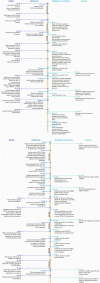The first eight months of Sweden's COVID-19 strategy and the key actions and actors that were involved
- PMID: 32951258
- PMCID: PMC7537539
- DOI: 10.1111/apa.15582
The first eight months of Sweden's COVID-19 strategy and the key actions and actors that were involved
Abstract
Aim: COVID-19 has affected millions of people worldwide. This paper reviews the Swedish pandemic response.
Methods: A narrative review was carried out and a timeline constructed.
Results: By September 1, 2020, 0.8% of Swedish residents had tested positive for the virus and 0.06% of the population had died, which was higher than neighbouring Nordic countries, but lower than some European countries with general lockdowns. The main actors were the Public Health Agency, the National Board of Health and Welfare, the Civil Contingencies Agency and the Government. County councils and regions implemented policies, in conjunction with the Department of Education and county administrative boards. Sweden's response was less invasive than many other countries, with no general lockdown. It focused on mitigation: slowing, but not stopping, the pandemic. Physical distancing was recommended in public spaces, but mandatory in bars, restaurants and at events. Visits to nursing facilities were banned. Kindergartens and schools for children up to 16 stayed open, but closed for older children for three months. There were no enforced quarantines for infected households or geographical regions, and facemasks were not recommended outside health care.
Conclusion: Sweden chose a different pandemic strategy to its peer nations. This paper examines the first eight months.
Keywords: COVID-19; coronavirus; pandemic; social distancing; transmission.
© 2020 The Authors. Acta Paediatrica published by John Wiley & Sons Ltd on behalf of Foundation Acta Paediatrica.
Conflict of interest statement
None.
Figures



References
Publication types
MeSH terms
LinkOut - more resources
Full Text Sources
Medical

